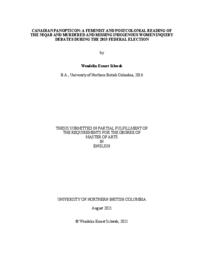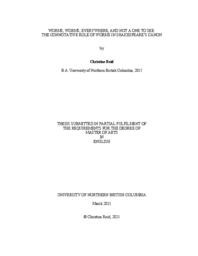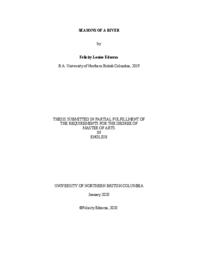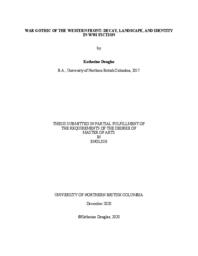University of Northern British Columbia. English
Related Works
Content type
Digital Document
Origin Information
Content type
Digital Document
Description / Synopsis
Canada is a settler-colonial state that specially targets and others minority groups, such as Indigenous peoples and recent immigrants. This was no more apparent than during the 2015 federal election, which saw debates on whether to ban Muslim women from wearing niqabs and other head coverings and whether to hold an inquiry into the epidemic of missing and murdered Indigenous women. By examining excerpts from speeches, tweets, articles, and interviews made by politicians, citizens, and journalists, this thesis traces the shape of settler-colonial systems and their impact on Indigenous and immigrant women. Canadian society demands conformity to sexual and cultural norms that require walking a tightrope of these double-edged ideals. Conformity is maintained through societally enforced regimes, known as the Panopticon, where each individual is both prisoner and guard. This constant surveillance does not simply end there, however, as Canadian settler society has different gender structures and norms for both men and women: women are subject to far stricter social expectations than men and, as this thesis brings to light, women in minority groups, such as indigenous and Muslim women, fall under an even harsher Canadian spotlight.
Origin Information
Content type
Digital Document
Description / Synopsis
In this thesis I draw on deconstruction theory and queer theory to analyze the current representation of sex, gender, and sexuality in Canadian television. Through this research I found that although Canadian television is portraying an increasing number of queer genders and sexualities, misinformation and stereotypes continue to perpetuate a one-dimensional characterization of people. This research pertains directly to my creative thesis: a pilot episode of a TV series which fraternal twins, Jed and Theodora, grow up with the ability to switch into one another's body. I dive directly into the correlation between sex and gender and the lived experience of being in a body that does not necessarily represent gender. The will both create a new gendered "construction" as well as question the need for gender identifications.
Origin Information
Content type
Digital Document
Description / Synopsis
In literature and film, werewolves have gone through an incredibly varied series of portrayals, but, throughout all of their changes (cycling largely between being antagonists and protagonists), werewolves have always interacted with the essentialist concept of the human-animal binary. Mutable at their core, werewolves reflect the people, places, and times of their various manifestations; the werewolf is whatever we need it to be. The fact that werewolves are inherently liminal creatures means that, for the purposes of my thesis' discussion, werewolves can serve as a tool for addressing preconceived notions of human exceptionalism (i.e., anthropocentrism). I question the assumptions of boundaries and socalled human traits with a story about embracing the uncertainty that our classifications and labels seek to efface. Simultaneously, I draw attention to female werewolves to level a concurrent challenge against patriarchal scripts that denigrate the association of human females with non-human animals. Just as many historical portrayals of werewolves reinforce the negative connotations of a woman-animal alignment, so too do contemporary representations of female werewolves become subject to portrayals that reinforce patriarchal values, rather than challenge them. Therefore, my focus is two-fold: to present an alternative narrative (in the form of a theory piece married to a novel) that draws attention to the artificial nature of both anthropocentrism and androcentrism. These two ways of thinking—that humans are inherently more important than animals and that the perspectives of male humans, in particular, trump all other points of view—are inextricably linked in their ideological othering of alternative experiences of being. The female werewolf, an embodiment of both inferior entities, is a well-suited symbol to decentralize dominant patriarchal narratives. Presented herein is my theory piece and the first fifteen chapters of my novel, Then, We Were Wolves, Again. It is a story about a woman who becomes the wolf she was all along and a man who undergoes a transformation but does not change. As a human, the protagonist, Harley, drifted through life like a lone wolf, but now, as an actual werewolf, she struggles to reconcile her instinctual need for her pack with her growing sense of disenchantment with her fellow lycanthropes. Indoctrinated by their leader, Arden, they're convinced of their sovereignty as a superior species to humans, but this new werewolf picks away at the cracks of hypocrisy, revealing the same species-centric thinking the wolves claim to transcend.
Origin Information
Content type
Digital Document
Description / Synopsis
The study of animals in Shakespeare’s collected works has expanded over the last 30 years. While a number of different animals have been discussed, the importance of the worm in the larger scope of the canon has largely been ignored. By focusing on the perception and presentation of worms in relation to cultural ideas of death, corruption, and consumption, ideas surrounding the body and soul are brought to the forefront. Worms are integral to our understanding of the Early Modern cultural constructs of the body and soul as the presence of worms reveals the state of the individual or the broader environment. Overall, the depiction of worms in Shakespeare’s works serves as a way to understand the metaphysical processes surrounding death and corruption.
Origin Information
Content type
Digital Document
Description / Synopsis
Seasons of a River is a fictional story about a woman looking back on her life. In her recollections she has to acknowledge and come to terms with the fact that her relationships with indigenous people in Canada have been inequitable and unbalanced. She realizes that she has been in the role of helper, of ally, and as such has perpetuated ideas of colonization and oppression, despite her good intentions. The protagonist, Annan, is in the process of trying to understand the complicated issues involved with the helping industry and her part within that industry. My introduction discusses the power differentials within allyship relations. I discuss how liberalism, at the root of the helping industry, although seen as a positive ideology, often perpetuates inequities and injustices when dealing with groups that are seen as “different.” I also discuss the importance of relationship building and listening and the need for quelling the tendency to assist others without consultation. This introduction and story also contain themes of ageism and how these attitudes are woven into the fabric of society in such a way as to internalize oppression and the idea of staying in one’s “place.” Ultimately, this story is about transformation.
Origin Information
Content type
Digital Document
Description / Synopsis
The First World War was a unique and unrepeatable Gothic event, and so, this thesis examines its modern and postmodern literary accounts within the War Gothic framework. Analysing Erich Maria Remarque’s All Quiet on the Western Front, Gabriel Chevallier’s Fear, Sebastian Barry’s A Long Long Way, and Joseph Boyden’s Three Day Road, it looks at the relationships of transformative states; specifically, the decomposition and destruction of the body, the landscape, identity, and masculinity along the trenches of the Western Front. Moreover, this thesis explores how the Gothic nature of WWI affects identity politics in the four novels according to personal, cultural, and national authorial subject positions. The War Gothic unites the German and French narratives with the previously unrepresented, and now re-imagined, Irish Catholic and Indigenous Canadian war experiences for the Gothic communicates the ineffable complexities of human nature and of war.
Origin Information







